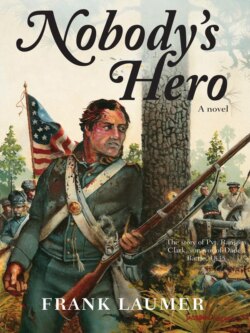Читать книгу Nobody's Hero - Frank Laumer - Страница 7
ОглавлениеPreface
Ransom Clark, private, Company C, Second Regiment of Artillery, joined the army when he was twenty-one. Two years later he was in Brevet Major Francis Langhorne Dade’s battle with the Seminole Indians in Florida on December 28, 1835. Of the 108 officers and men of Dade’s command, only Clark and one other soldier survived the battle and made it back to Fort Brooke on Tampa Bay. The destruction of this command, nearly one-fifth of the regular force then serving in Florida, was the pretext needed by the United States to begin what was to be the longest Indian war in American history.
Clark—his right pelvis shattered, a bullet in his right lung, another through his right shoulder—was discharged in May 1836 with a pension of seven dollars a month. He returned to his hometown, Greigsville, New York, married, and had a child. Permanently disabled by his wounds, he attempted to provide for his family by giving lectures on his experiences in Florida. He also wrote a brief account published in 1839 titled The Surprising Adventures of Ransom Clark: Among the Indians in Florida. In his Introduction he wrote: “It is not the design of the subscriber to give . . . a full account of his adventures or disasters. Arrangements, however, are being made . . . to put forth an entire account of his life and adventures. But he was not given time to complete this work. The wound in his shoulder never healed. He died of infection in 1840, age twenty-eight.
My home is fifteen miles south of Dade’s battlefield, now Dade Battlefield State Historic site. Forty-six years ago I visited the battlefield for the first time. Upon inquiry I found that a history of the battle was not available, only the date and a few names. I began to write letters, make phone calls, visit libraries. Quickly it became apparent that this forgotten battle had initiated the equally forgotten Florida War. During this seven-year struggle the army cleared three thousand miles of road through a mosquito- and snake-infested wilderness, sent over forty thousand men into jungle warfare against Seminole Indians, and built some four hundred forts. Hundreds of miles of those roads are now U.S. highways and many of the forts have become cities. Hundreds of towns and several counties in Florida carry the names, both white and Seminole, of the leaders of this long, painful struggle, while descendants of the few hundred Indian survivors who escaped death or deportation form the present Seminole Nation.
More personally, I came to realize that Ransom Clark was a remarkable man. Through the years I have gathered much information about him, exhumed his remains, held his bones in my hands. It became apparent to me that this man needed to have his story completed, the “entire account of his life and adventures” told. I have taken the bones of fact and put upon them the flesh of fiction.
